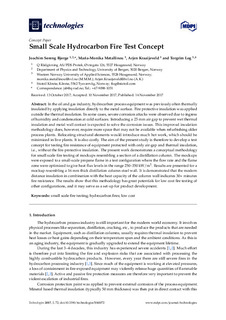| dc.contributor.author | Bjørge, Joachim Søreng | |
| dc.contributor.author | Metallinou, Maria-Monika | |
| dc.contributor.author | Kraaijeveld, Arjen | |
| dc.contributor.author | Log, Torgrim | |
| dc.date.accessioned | 2019-10-16T11:02:43Z | |
| dc.date.available | 2019-10-16T11:02:43Z | |
| dc.date.created | 2017-12-14T20:31:02Z | |
| dc.date.issued | 2017 | |
| dc.identifier.citation | Bjørge, J., Metallinou, M.-M., Kraaijeveld, A., & Log, T. (2017). Small Scale Hydrocarbon Fire Test Concept. Technologies, 5(4). | nb_NO |
| dc.identifier.issn | 2227-7080 | |
| dc.identifier.uri | http://hdl.handle.net/11250/2622523 | |
| dc.description.abstract | In the oil and gas industry, hydrocarbon process equipment was previously often thermally insulated by applying insulation directly to the metal surface. Fire protective insulation was applied outside the thermal insulation. In some cases, severe corrosion attacks were observed due to ingress of humidity and condensation at cold surfaces. Introducing a 25 mm air gap to prevent wet thermal insulation and metal wall contact is expected to solve the corrosion issues. This improved insulation methodology does, however, require more space that may not be available when refurbishing older process plants. Relocating structural elements would introduce much hot work, which should be minimized in live plants. It is also costly. The aim of the present study is therefore to develop a test concept for testing fire resistance of equipment protected with only air-gap and thermal insulation, i.e., without the fire-protective insulation. The present work demonstrates a conceptual methodology for small scale fire testing of mockups resembling a section of a distillation column. The mockups were exposed to a small-scale propane flame in a test configuration where the flow rate and the flame zone were optimized to give heat flux levels in the range 250–350 kW/m2. Results are presented for a mockup resembling a 16 mm thick distillation column steel wall. It is demonstrated that the modern distance insulation in combination with the heat capacity of the column wall indicates 30+ minutes fire resistance. The results show that this methodology has great potentials for low cost fire testing of other configurations, and it may serve as a set-up for product development | nb_NO |
| dc.language.iso | eng | nb_NO |
| dc.publisher | MDPI | nb_NO |
| dc.rights | Navngivelse 4.0 Internasjonal | * |
| dc.rights.uri | http://creativecommons.org/licenses/by/4.0/deed.no | * |
| dc.subject | small scale fire testing | nb_NO |
| dc.subject | hydrocarbon fires | nb_NO |
| dc.subject | low cost | nb_NO |
| dc.title | Small Scale Hydrocarbon Fire Test Concept | nb_NO |
| dc.type | Journal article | nb_NO |
| dc.type | Peer reviewed | nb_NO |
| dc.description.version | publishedVersion | nb_NO |
| dc.rights.holder | © 2017 by the authors. | nb_NO |
| dc.source.pagenumber | 14 | nb_NO |
| dc.source.volume | 5 | nb_NO |
| dc.source.journal | Technologies | nb_NO |
| dc.source.issue | 4 | nb_NO |
| dc.identifier.doi | 10.3390/technologies5040072 | |
| dc.identifier.cristin | 1527701 | |
| cristin.unitcode | 203,6,2,0 | |
| cristin.unitname | Avdeling for tekniske, økonomiske og maritime fag - Stord/Haugesund | |
| cristin.ispublished | true | |
| cristin.fulltext | original | |
| cristin.qualitycode | 1 | |

